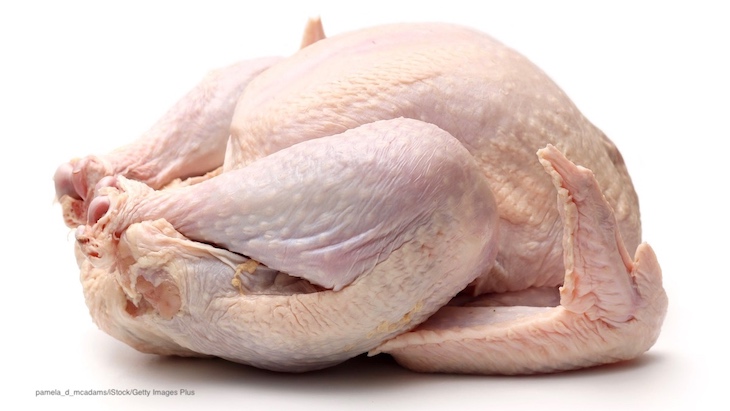Most people know that raw poultry, as well as raw meat and eggs, are potentially hazardous foods. These foods are often contaminated with pathogens that can make you very sick. If not handled and cooked properly, the risk of foodborne illness with these foods is quite high. This is what you need to know about chicken and food safety.

Americans eat more chicken than any other meat. Outbreaks linked to chicken are common every year. The bird is often contaminated with Campylobacter and Salmonella bacteria, which is why about 1,000,000 people in the U.S. get sick from contaminated poultry every year.
First, when shopping, buy chicken last. Double bag it at the store, then go home right away and refrigerate or freeze any chicken product. Don’t make other stops or delay going home.
When storing chicken in the fridge, do not put it on a shelf above foods that are eaten raw, such as lettuce and fruit. Raw chicken juices, which are probably contaminated, can easily drip down onto the produce in a process called cross-contamination. Keep chicken on the lowest shelf, and put the package inside a tray with sides to control juices. Raw chicken should be cooked or frozen within a few days; follow use by instructions on the package.
Frozen chicken should be thawed in the fridge, never on the countertop. You can put the chicken in cold water in the sink, changing the water every 30 minutes, until the chicken is thawed. Cook thawed chicken immediately.
When preparing chicken, first wash your hands well with soap and water and dry them using paper towels. Do NOT wash or rinse raw chicken, since the bacteria that may be on the surface will aerosolize under the water and will spread up to three feet away from the faucet.
Always use a separate cutting board when working with raw chicken. Wash cutting boards, utensils, countertops, and dishes with hot soapy water after they have been in contact with chicken. And remember to never put cooked food or fresh produce on a plate or surface that held raw chicken without washing the surface thoroughly.
Always cook all chicken to 165°F and measure that temperature with a reliable food thermometer. If you are using the microwave to cook chicken there may be cold spots where bacteria could survive. Measure the temperature in several spots.
Finally, refrigerate any dish containing cooked chicken after it has been out of the oven or the refrigerator for 2 hours; one hour if the ambient air temperature is above 90°F. Now that you understand chicken and food safety you can keep yourself and your family safe.




